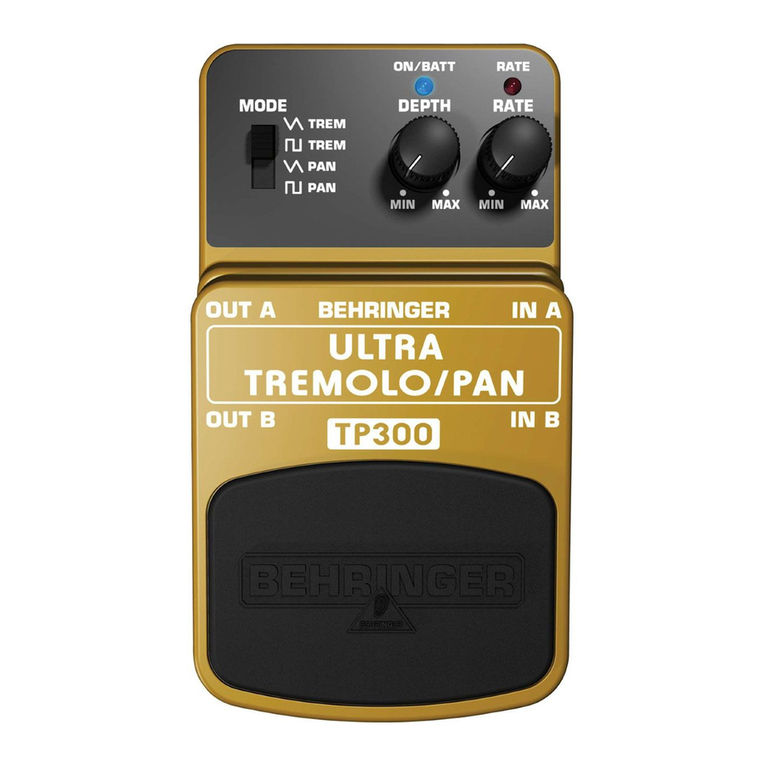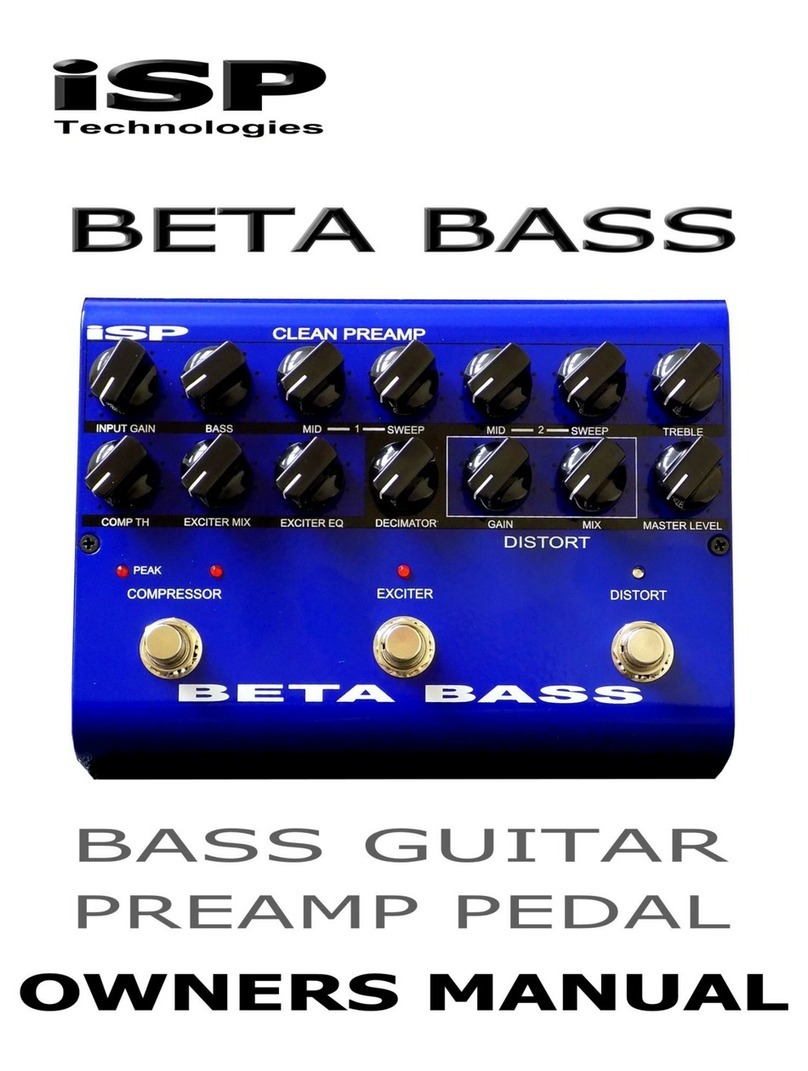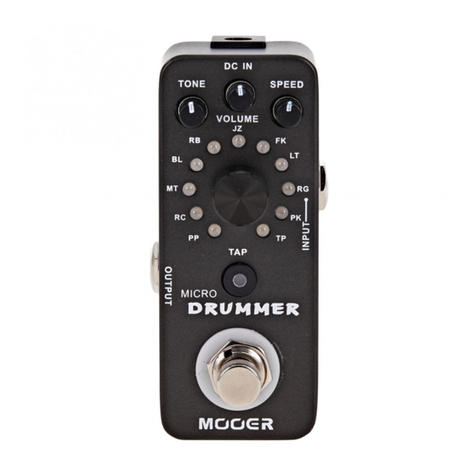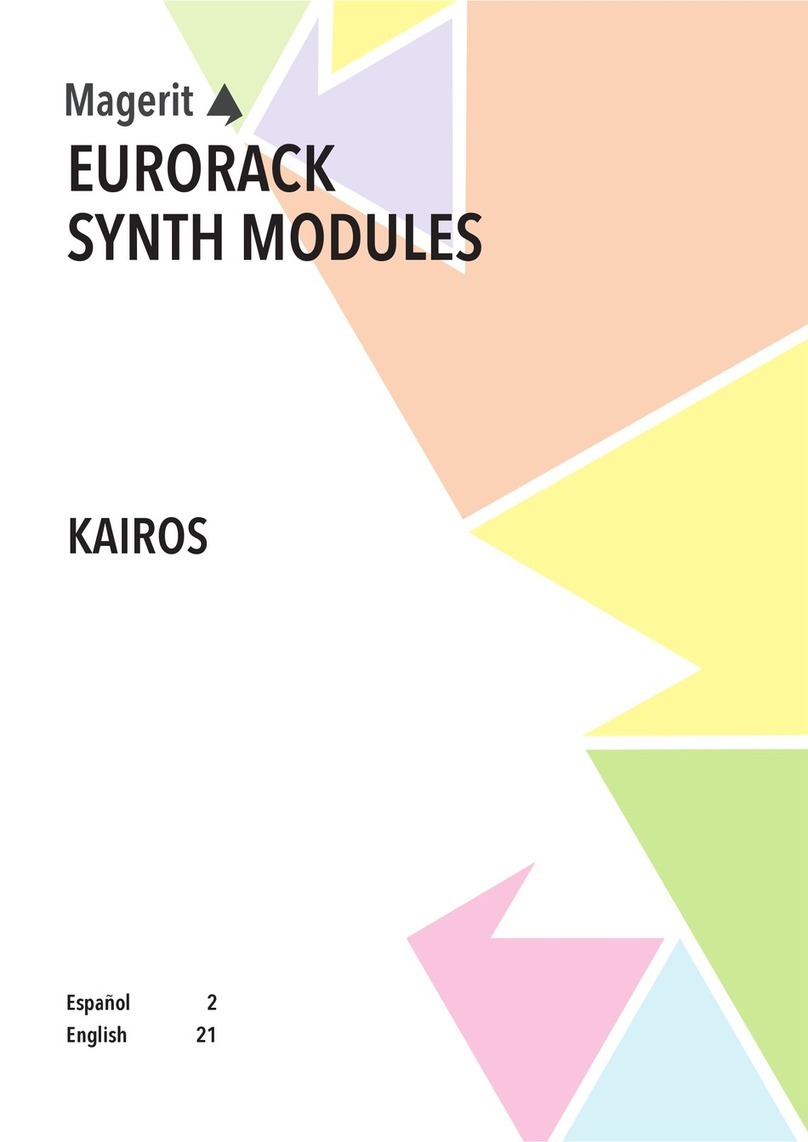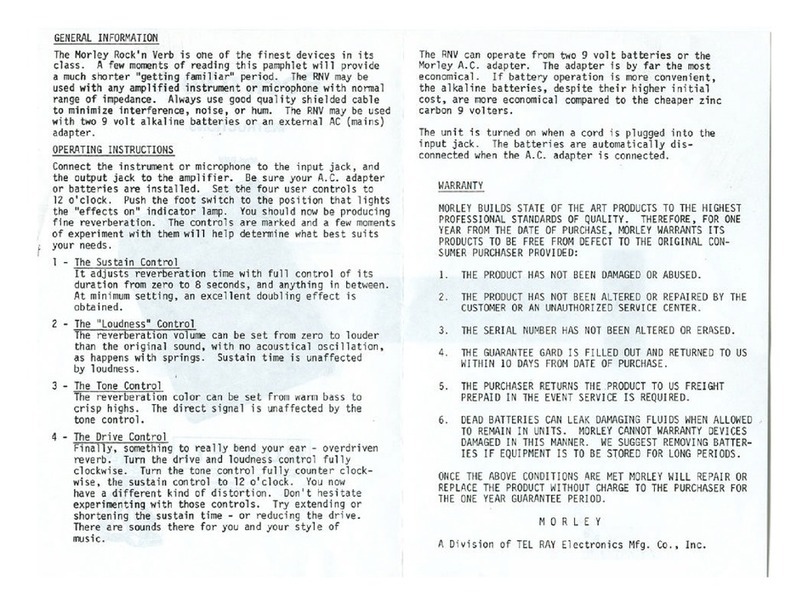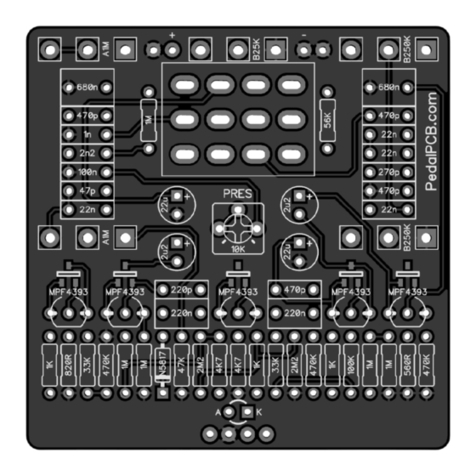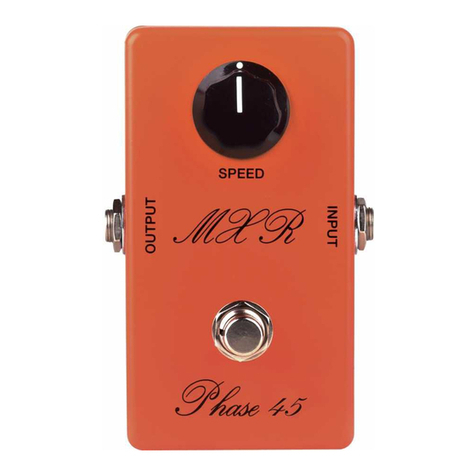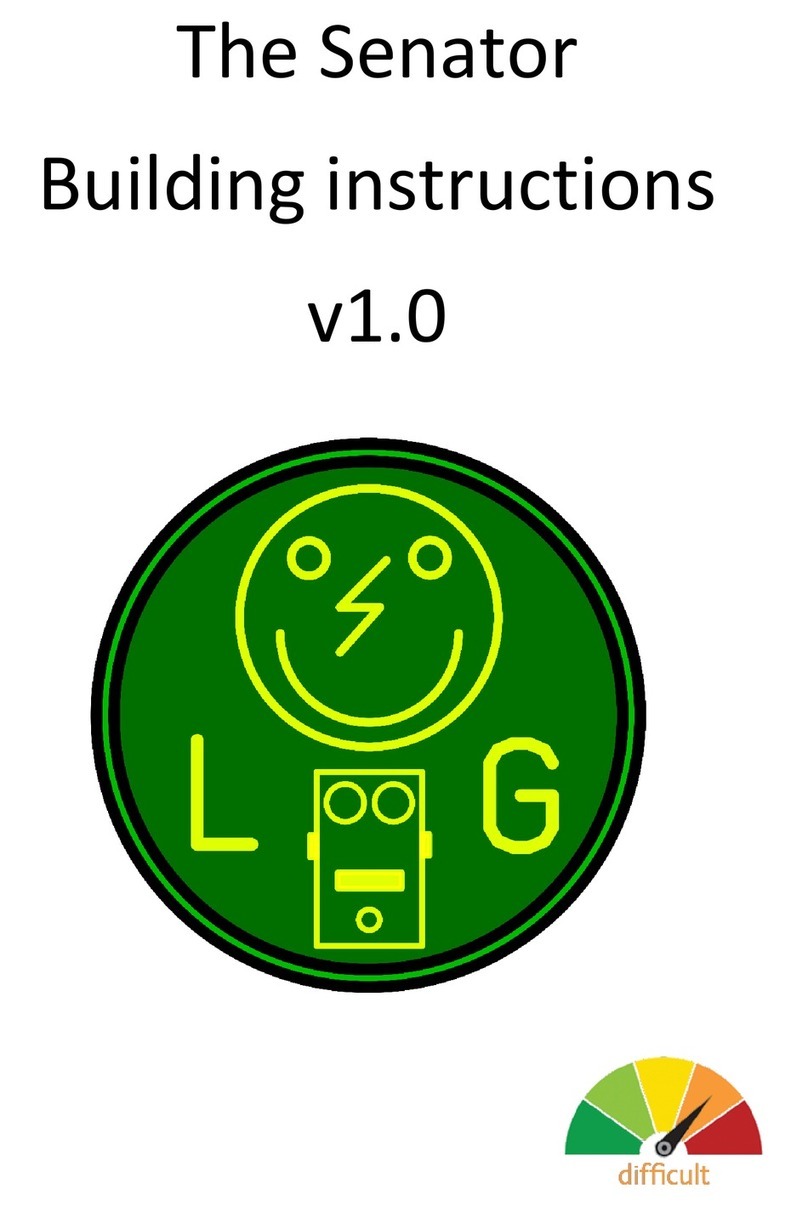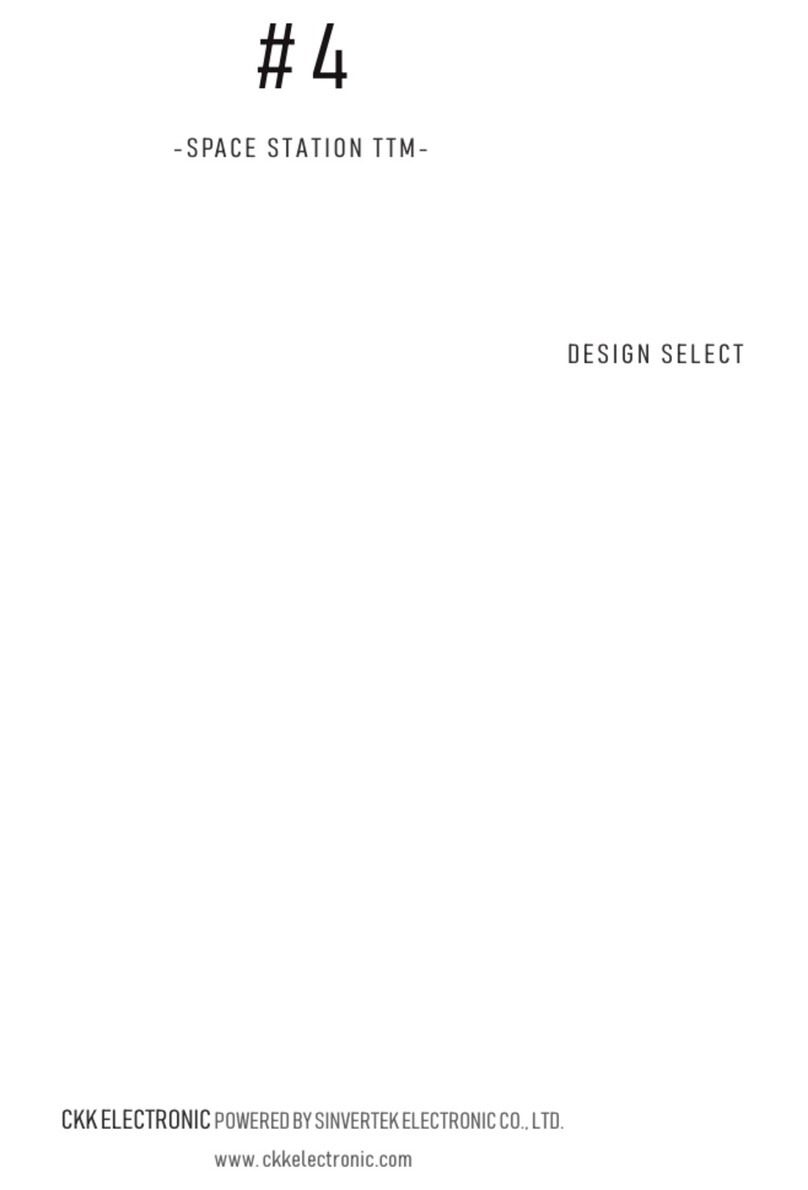Demedash Effects T-60 ANALOG MODULATOR User manual

© 2021 Demedash Eects, all rights reserved
ANALOG
MODULATOR
DEMEDASH
EFFECTS
sAMpLe seTTiNGs
TAP TEMPO
Sets either LFO speed or chop rate, depending on ‘Tempo Target’
selection. Honors last two stomps.
The LED indicator will blink red & yellow at the entered tempo until 3
seconds after the last tap have elapsed. If the unit is in bypass, the
indicator will alternate between yellow & off to indicate the tempo.
The divisions setting does not affect the rate of the flashing LED.
Notes:
When “Chop” is the tap parameter, the tempo entered is subdivided
by the divisions selection and then further subdivided by 4 before being
applied.
Tapping a rate/chop value into the Random LFO causes it to output
samples at a regular (rather than semi-random) interval - 4 samples will
be output per tap interval (or per the interval given after applying the
current subdivision setting).
RAMPING
Hold the Tap/Ramp footswitch down to begin ramping. The Rate/Chop
setting will either begin increasing (if the Rate/Chop knob is left of noon)
or decreasing (if the Rate/Chop knob is at or above noon). When the
up/lower-most value is reached, the led quickly blinks yellow. Release
to exit the ramp, and Rate/Chop will drift back up/down to the original
setting (whether that was set via tap tempo or via the respective knob).
RAMp pARAMeTeRs:
While the Tap/Ramp switch is held down and ramping is engaged,
these alternate parameters can be adjusted. Once one of these
parameters is changed, it takes effect immediately, and is stored in
memory so that it will be recalled next time you use the pedal.
RAMp MODe [DEPTH KNOB]:
Choose between ‘Stretch’ ramping (default), and ‘Bounce’ ramping. The
LED indicator will blink while turning this knob when the current setting
has changed.
Stretch: ramp Rate/Chop to the furthest extreme away from the
current setting and hold it there until the footswitch is released (Stret
Bounce: ramp Rate/Chop to the furthest extreme away from the
current setting, then once there, reverse directions and go to the other
extreme, over and over.
RAMp RATe [RATE KNOB]:
Control how quickly a parameter is varied while ramping.
RAMp TARGeT [CHOP KNOB]:
Choose whether ‘Rate’ or ‘Chop’ will be ramped when you hold down the
‘Tap’ footswitch. The LED indicator will blink while turning this knob when
the current setting has changed.
Tap Tempo & Ramping
SWEEPING
RESONANT
FILTER
GLITCHY
FLANGER
MOTIONLESS
CHORUS
GLOSSY
CHORUS
WIDE
VIBRATO
ANALOG
COMPUTER
EQLAG
MIX
REGEN
RANDOM
DEPTH RATE
CHOP

DEMEDASH EFFECTS T-60 ANALOG MODULATOR
STEREO OUTPUT
To take advantage of the stereo output capabilities of the T-60, use a 1/4”
TRS cable on the output (use a TRS to dual TS Y-splitter if sending the 2
outputs to 2 separate input jacks).
No special considerations are necessary when using a mono output.
POWER
+9v Center Negative Power supply (not included). Input voltages above 10v
will be blocked by the unit to prevent damage to the internal circuitry.
Approx. 90mA Power Consumption
Control overview
DEPTH
Set how widely the pitch swings as it is modulated.
REGEN. [ALT PARAMETER]:
Regeneration causes the wet, effected signal to feed back upon itself,
creating resonant peaks and notches and intensifying the effect.
Very interactive with Lag. Using some regen with a low lag setting will
enunciate moving-filter effects (make sure mix is set to noon for these).
High regeneration settings will lead to self-oscillation, especially when
using higher lag, but this will not harm the unit.
CHOP
Reduce the ‘Sampling Rate’ of the Periodic LFO, and reduce the time it
takes for the Random LFO to glide from one output value to the next.
Sample rate reduction of the Periodic LFO creates a staircase-like
waveform that introduces glitchy little pitch jumps into the vibrato as the
pitch sweeps up and down.
Glide reduction of the random waveform introduces more abrupt pitch
jumps, taking you from a smooth, subtle pitch waver into the territory of
computer sounds.
Increased regeneration and longer lag settings can both help to
accentuate this effect.
RANDOM [ALT PARAMETER]:
Mix between the Periodic & Random LFOs - 2 fully independant,
simultaneously generated waveforms both dialed in via the Rate, Chop &
Depth controls.
Fully CCW: Pure periodic LFO. A mix of Sine & Triangle waveforms,
Perfect for a classic chorus or vibrato tones.
Fully CW: Pure Random LFO. Ideal for atmospheric, motionless vibrato &
chorus. With chop low, this gives the sound of stretched tape. With chop
high, it yields the sound of a glitched out computer.
Set this control anywhere in between to find the perfect balance between
reliable and inspiring.
LAG
Sets the resting clock speed of the analog delay line used to generate the
wet signal. Very interactive with Regen.
Clockwise = slower clock, longer lag, wider pitch swing.
Counter Clockwise = faster clock, shorter lag, more swept filter effects.
Low lag settings are where you’ll find the sweeping phase cancellation
phenomenon at the heart of flanging (you’ll neet to set mix around noon
as well). This is one place where use of regeneration really shines.
Mid-length lag settings give a more standard glassy chorusing sound.
Long lag times give way to wide pitch vibrato territory. This is best if
you’re playing with the mix knob set to full vibrato, or if you’re after a very
thick chorus sound. Regen should be set low or off for this, so as to avoid
self-oscillation.
This is a knob you’ll need to play with and find the setting that’s right for
you.
MIX
Blend between dry unmodulated signal and the wet, pitch modulated
signal.
For vibrato (no dry signal), turn fully clockwise. Longer lag times often
sound best when using the unit purely for vibrato.
For Chorus (even amounts dry and wet) set to 12 o’clock. Set here, you
can experiment with the Lag knob to dial in a variety of modulated sounds.
EQ
The T-60 features a brilliant little EQ circuit that can be set to apply to the
wet signal only, or to both the dry and wet signals together (see ‘DRY EQ’).
EQ allows you to sculpt the frequency response of your signal in any
number of ways.
Rather than providing a typical tone-stack-style response, this control
lets you roll off treble as you turn it down, leave the output unchanged by
setting the knob at noon, or roll off bass and retain only the treble content
as you turn it clockwise.
DRY EQ
Choose whether the EQ Knob affects the overall signal (wet + dry) or the
wet signal only, leaving your dry signal untouched.
To toggle this, do as follows: with the effect engaged, hold down the ‘Eng/
Alt’ footswitch until the indicator LED turns yellow, then Tap on the ‘Tap/
Ramp’ footswitch to toggle the Dry EQ mode.
The indicator LED will blink 3 times in a color that indicates the EQ Mode:
Red: EQ setting applies to BOTH Dry & Wet
Yellow: EQ setting applies ONLY to Wet.
TEMPO TARGET
Choose whether you’d like to tap in the LFO rate or the Chop rate. The
selection for tap divisions will apply to either one you choose.
Similarly to toggling Dry EQ, with the effect engaged, hold down the ‘Tap/
Ramp’ footswitch, and then tap on the ‘Eng/Alt’ footswitch.
The LED will blink 3 times to indicate the new setting:
Red: LFO rate is targeted by tap tempo
Yellow: Chop rate is targeted by tap tempo.
RATE
Sets the speed of the LFO that modulates the wet signal. Simply, the speed of the chorus/vibrato modulation.
DIVISIONS [ALT PARAMETER]:
Select between four tap tempo divisions, from counterclockwise to clockwise: Quarter, Dotted Eighth, Eighth, Triplet.
While turning this knob, the LED indicator will indicate change by blinking each time a new division setting is landed on.
Changing the divisions will update the current tempo ONLY IF the current tempo was entered via tap.
Changing the divisions setting will not have any impact on the range of the Rate or Chop knobs, and will not alter any setting you currently have dialed in via
those knobs.
ENG/ALT FOOTSWITCH
Press and release quickly to engage or bypass the effect.
Momentary Engage:
When in bypass, press and hold the footswitch for 2+ seconds to utilize
‘momentary’ activation - ie, the effect will engage upon the initial press, and
then disengage once the footswitch is released.
Alt Parameters:
When engaged, press and hold until the indicator LED turns yellow to
access the secondary parameters (Regen, Divs, & Random). Turn the
knobs associated with these while holding the footswitch to modify their
values. Once the footswitch is released, the settings of the primary
parameters associated with these knobs will not have changed. Secondary
parameter settings are retained in memory between power cycles.
Other Demedash Effects Music Pedal manuals

